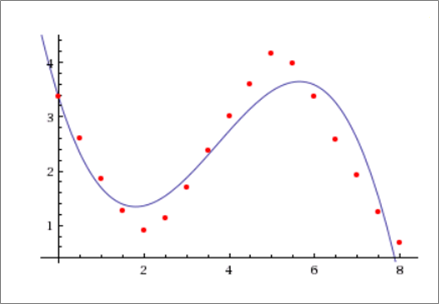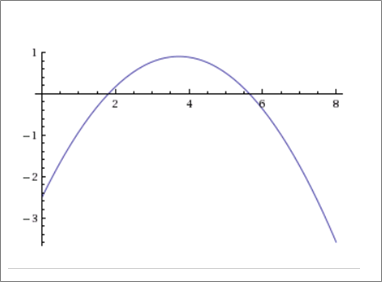
Concept explainers
a.
To estimate: when Priya is moving toward the motion detector, away from the motion detector.
a.
Answer to Problem 58E
: moving towards the motion detector again.
Between 1.5 and 2.5 there is a
t = 2.
Between 4.5 and 5.5 there is a
t = 5.
Explanation of Solution
Given information: Priya’s distance D in meters from a motion detector is given by the
data in below table.
| t (sec) | D (m) | t (sec) | D (m) |
| 0.0 | 3.36 | 4.5 | 3.59 |
| 0.5 | 2.61 | 5.0 | 4.15 |
| 1.0 | 1.86 | 5.5 | 3.99 |
| 1.5 | 1.27 | 6.0 | 3.37 |
| 2.0 | 0.91 | 6.5 | 2.58 |
| 2.5 | 1.14 | 7.0 | 1.93 |
| 3.0 | 1.69 | 7.5 | 1.25 |
| 3.5 | 2.37 | 8.0 | 0.67 |
| 4.0 | 3.01 |
Calculation:
D (t) is increasing when Priya is moving away and decreasing when moving towards the motion detector.
: moving towards the motion detector again.
Between 1.5 and 2.5 there is a local minimum, but cannot be sure about the direction at
t = 2.
Between 4.5 and 5.5 there is a local maximum, but cannot be sure about the direction at
t = 5.
b.
To give: an interpretation of any local extreme values in term of this problem situation.
b.
Answer to Problem 58E
At t = 2 Priya is at relative minimum distance to the detector . At t = 5 Priya is at a relative maximum distance from the detector.
Explanation of Solution
Calculation:
At t = 2 Priya is at relative minimum distance to the detector . At t = 5 Priya is at a relative maximum distance from the detector.
c.
To find: a cubic regression equation for the table data and superimpose its graph on a
c.
Answer to Problem 58E
Explanation of Solution
Calculation:
The cubic regression equation for the table data using graphing utility is:
The graph of the above model is shown below.

d.
To find: a formula for f’ using the model in part (c) and use this formula to estimate the answers to (a).
d.
Answer to Problem 58E
Interval:
(0, 1.8) − moving towards door.
(1.8, 5.6) − moving away.
(5.6, 8) − moving towards.
Explanation of Solution
Given information:
Calculation:
The graph of the f’ (t) is shown below.

From the graph:
When f’ (t) < 0 .the distance f (t) is decreasing.
When f’ (t) >0 . the distance f (t) is increasing.
Interval:
(0, 1.8) − moving towards door.
(1.8, 5.6) − moving away.
(5.6, 8) − moving towards.
Chapter 5 Solutions
Calculus 2012 Student Edition (by Finney/Demana/Waits/Kennedy)
Additional Math Textbook Solutions
University Calculus: Early Transcendentals (4th Edition)
A Problem Solving Approach To Mathematics For Elementary School Teachers (13th Edition)
A First Course in Probability (10th Edition)
Basic Business Statistics, Student Value Edition
Elementary Statistics (13th Edition)
Elementary Statistics: Picturing the World (7th Edition)
- 3. Consider the polynomial equation 6-iz+7z² - iz³ +z = 0 for which the roots are 3i, -2i, -i, and i. (a) Verify the relations between this roots and the coefficients of the polynomial. (b) Find the annulus region in which the roots lie.arrow_forwardForce with 800 N and 400 N are acting on a machine part at 30° and 60°, respectively with the positive x axisarrow_forwardFind the accumulated amount A, if the principal P is invested at an interest rate of r per year for t years. (Round your answer to the nearest cent.) P = $13,000, r = 6%, t = 10, compounded quarterly A = $ 31902 Need Help? Read It Watch It Viewing Saved Work Revert to Last Response SUBMIT ANSWER O/6.66 Points] DETAILS MY NOTES TANAPCALC10 5.3.003. EVIOUS ANSWERS ASK YOUR TEACHER PRACTICE ANOTHER Find the accumulated amount A, if the principal P is invested at an interest rate of r per year for t years. (Round your answer to the nearest cent.) P = $140,000, r = 8%, t = 8, compounded monthly A = $259130.20 X Need Help? Read It Watch Itarrow_forward
- Find the present value of $20,000 due in 3 years at the given rate of interest. (Round your answers to the nearest cent.) (a) 2%/year compounded monthly (b) 5%/year compounded daily $ Need Help? Read It Watch It SUBMIT ANSWER [-/6.66 Points] DETAILS MY NOTES TANAPCALC10 5.3.009. ASK YOUR TEACHER PRACTICE ANC Find the accumulated amount after 3 years if $4000 is invested at 3%/year compounded continuously. (Round your answer to the nearest cent.) Need Help? Read It Watch Itarrow_forwardFind the effective rate corresponding to the given nominal rate. (Round your answers to three decimal places.) (a) 9.5%/year compounded monthly % (b) 9.5%/year compounded daily % Need Help? Read It Watch It SUBMIT ANSWER -/6.66 Points] DETAILS MY NOTES TANAPCALC10 5.3.007. ASK YOUR TEACHE Find the present value of $90,000 due in 7 years at the given rate of interest. (Round your answers to the nearest cent.) (a) 9%/year compounded semiannually (b) 9%/year compounded quarterly LAarrow_forwardFind the accumulated amount A, if the principal P is invested at an interest rate of r per year for t years. (Round your answer to the nearest cent.) P = $160,000, r = 7%, t = 4, compounded daily A = $211113.60 Need Help? Read It SUBMIT ANSWER ASK YOUR TEACHER PRACTICE ANOTHER --/6.66 Points] DETAILS MY NOTES TANAPCALC10 5.3.005. Find the effective rate corresponding to the given nominal rate. (Round your answers to three decimal places.) (a) 8%/year compounded semiannually % (b) 9%/year compounded quarterly %arrow_forward
- Find the derivative of the function. g'(t) = 9t g(t) = In(t) (9ln(t) - 1) [In(t)] 2 × Need Help? Read It Watch Itarrow_forwardFind the accumulated amount A, if the principal P is invested at an interest rate of r per year for t years. (Round your answer to the nearest cent.) P = $3800, r = 4%, t = 10, compounded semiannually A = $ 5645.60 × Need Help? Read It SUBMIT ANSWER [3.33/6.66 Points] DETAILS MY NOTES REVIOUS ANSWERS ASK YOUR TEACHER TANAPCALC10 5.3.001.EP. PRACTICE ANOTHER Consider the following where the principal P is invested at an interest rate of r per year for t years. P = $3,100, r = 4%, t = 10, compounded semiannually Determine m, the number of conversion periods per year. 2 Find the accumulated amount A (in dollars). (Round your answer to the nearest cent.) A = $ 4604.44arrow_forwardForce with 800 N and 400 N are acting on a machine part at 30° and 60°, respectively with a positive x axis, Draw the diagram representing this situationarrow_forward
 Calculus: Early TranscendentalsCalculusISBN:9781285741550Author:James StewartPublisher:Cengage Learning
Calculus: Early TranscendentalsCalculusISBN:9781285741550Author:James StewartPublisher:Cengage Learning Thomas' Calculus (14th Edition)CalculusISBN:9780134438986Author:Joel R. Hass, Christopher E. Heil, Maurice D. WeirPublisher:PEARSON
Thomas' Calculus (14th Edition)CalculusISBN:9780134438986Author:Joel R. Hass, Christopher E. Heil, Maurice D. WeirPublisher:PEARSON Calculus: Early Transcendentals (3rd Edition)CalculusISBN:9780134763644Author:William L. Briggs, Lyle Cochran, Bernard Gillett, Eric SchulzPublisher:PEARSON
Calculus: Early Transcendentals (3rd Edition)CalculusISBN:9780134763644Author:William L. Briggs, Lyle Cochran, Bernard Gillett, Eric SchulzPublisher:PEARSON Calculus: Early TranscendentalsCalculusISBN:9781319050740Author:Jon Rogawski, Colin Adams, Robert FranzosaPublisher:W. H. Freeman
Calculus: Early TranscendentalsCalculusISBN:9781319050740Author:Jon Rogawski, Colin Adams, Robert FranzosaPublisher:W. H. Freeman
 Calculus: Early Transcendental FunctionsCalculusISBN:9781337552516Author:Ron Larson, Bruce H. EdwardsPublisher:Cengage Learning
Calculus: Early Transcendental FunctionsCalculusISBN:9781337552516Author:Ron Larson, Bruce H. EdwardsPublisher:Cengage Learning





